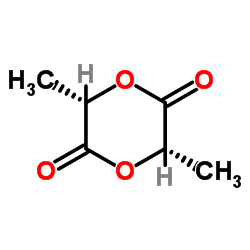L-Lactide

L-Lactide structure
|
Common Name | L-Lactide | ||
|---|---|---|---|---|
| CAS Number | 4511-42-6 | Molecular Weight | 144.125 | |
| Density | 1.2±0.1 g/cm3 | Boiling Point | 285.5±15.0 °C at 760 mmHg | |
| Molecular Formula | C6H8O4 | Melting Point | 92-98ºC | |
| MSDS | Chinese USA | Flash Point | 150.6±18.8 °C | |
| Symbol |

GHS07 |
Signal Word | Warning | |
|
Biocompatible, biodegradable and porous liquid crystal elastomer scaffolds for spatial cell cultures.
Macromol. Biosci. 15(2) , 200-14, (2015) Here we report on the modular synthesis and characterization of biodegradable, controlled porous, liquid crystal elastomers (LCE) and their use as three-dimensional cell culture scaffolds. The elastomers were prepared by cross-linking of star block-co-polymer... |
|
|
Injectable Peptide Decorated Functional Nanofibrous Hollow Microspheres to Direct Stem Cell Differentiation and Tissue Regeneration.
Adv. Funct. Mater. 25(3) , 350-360, (2015) Injectable microspheres are attractive stem cell carriers for minimally invasive procedures. For tissue regeneration, the microspheres need to present the critical cues to properly direct stem cell differentiation. In natural extracellular matrix (ECM), growt... |
|
|
Applicability of a newly developed bioassay for determining bioactivity of anti-inflammatory compounds in release studies--celecoxib and triamcinolone acetonide released from novel PLGA-based microspheres.
Pharm. Res. 32(2) , 680-90, (2015) To develop a bio-assay for measuring long-term bioactivity of released anti-inflammatory compounds and to test the bioactivity of celecoxib (CXB) and triamcinolone acetonide (TA) released from a new PLGA-based microsphere platform.Human osteoarthritic chondro... |
|
|
Sunitinib microspheres based on [PDLLA-PEG-PDLLA]-b-PLLA multi-block copolymers for ocular drug delivery.
Eur. J. Pharm. Biopharm. 95 , 368-77, (2015) Sunitinib is a multi-targeted receptor tyrosine kinase (RTK) inhibitor that blocks several angiogenesis related pathways. The aim of this study was to develop sunitinib-loaded polymeric microspheres that can be used as intravitreal formulation for the treatme... |
|
|
Oxygen plasma surface modification augments poly(L-lactide-co-glycolide) cytocompatibility toward osteoblasts and minimizes immune activation of macrophages.
J. Biomed. Mater. Res. A 103 , 3965-77, (2015) Here, we report on modification of one of the model biomedical polymers, poly L-lactide-co-glycolide (PLGA; 85:15), by reactive ion etching (RIE) oxygen plasma treatment. PLGA's major disadvantage is high hydrophobicity which restrains binding of cell-adhesiv... |
|
|
PLA-PEG Coated Multifunctional Imaging Probe for Targeted Drug Delivery.
Mol. Pharm. 12 , 1885-92, (2015) Monitoring of drugs in vivo has been recognized as an urgent need for successful chemotherapy treatment. However, to find an appropriate tool for this purpose has been proved as a great challenge. Here, we report a PLA-PEG coated hollow X-ray and upconversion... |
|
|
Preparation and in vitro antimicrobial activity of silver-bearing degradable polymeric nanoparticles of polyphosphoester-block-poly(L-lactide).
ACS Nano 9(2) , 1995-2008, (2015) The development of well-defined polymeric nanoparticles (NPs) as delivery carriers for antimicrobials targeting human infectious diseases requires rational design of the polymer template, an efficient synthetic approach, and fundamental understanding of the d... |
|
|
Improved antifungal activity of amphotericin B-loaded TPGS-b-(PCL-ran-PGA) nanoparticles.
Int. J. Clin. Exp. Med. 8 , 5150-62, (2015) To develop amphotericin B-loaded biodegradable TPGS-b-(PCL-ran-PGA) nanoparticles (PLGA-TPGS-AMB NPs) for fungal infection treatment, PLGA-TPGS NPs and PLGA NPs were synthesized by a modified double emulsion method and characterized in terms of size and size ... |
|
|
Feasibility of second-generation bioresorbable vascular scaffold implantation in complex anatomical and clinical scenarios.
Clin. Res. Cardiol. 104(2) , 124-35, (2015) Bioresorbable vascular scaffolds (BVS) have become an emerging tool to treat coronary artery disease. However, the current use of BVS is still widely restricted to stable patients and non-complex lesions. In real-world practice patients are far more complex t... |
|
|
A frame-supported ultrathin electrospun polymer membrane for transplantation of retinal pigment epithelial cells.
Biomed. Mater. 10 , 045022, (2015) We report on the design and fabrication of a frame-supported nanofibrous membrane for the transplantation of retinal pigment epithelial (RPE) cells, which is a promising therapeutic option for the treatment of degenerative retinal disorders. The membranous ce... |